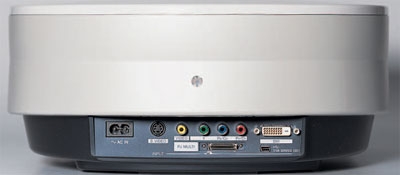LCD for Less Page 3

With its distinctive arch-shaped case and funny-sounding name, Sony's Cineza VPL-HS10 is hard to overlook. But perhaps the most noteworthy feature of this projector is that it offers HDTV picture quality for $3,000. The VPL-HS10 is equipped with a removable Cinema filter that attaches to the lens to boost image contrast. Both table and ceiling mounting are possible, but I'd recommend buying Sony's optional PSS-610 ceiling bracket ($300) since the VPL-HS10's fan noise is a few decibels louder than the other projectors in this test even when set to its low-lamp mode.
In addition to its three WXGA LCD panels, which have a native resolution of 1,366 x 768 pixels, the VPL-HS10's lens features 1.3x zoom. During setup, it allowed me enough range to position the projector between 11 3/8 and 14 1/4 feet from the screen. The VPL-HS10 can handle virtually any type of signal that you feed into it, from standard 480i to high-definition 720p and 1080i, even 1080p - the production format George Lucas used to shoot Star Wars II: Attack of the Clones. 
The VPL-HS10 provides a full suite of inputs, including wideband component-video and a DVI (Digital Visual Interface) jack with HDCP (High-bandwidth Digital Content Protection) for hooking up a new high-definition satellite receiver with a copy-protected DVI output. The DVI input can also be used with a computer. Another hookup option is a proprietary interface that Sony calls PJ Multi. The supplied cable that connects to this input has component-, composite-, and S-video plugs on one end, and you can also order an optional cable with a VGA connector. Finally, a slot on the projector's front panel accepts Memory Stick cards for watching slide shows of digital images.
 Sony's well-designed remote control has a fully backlit keypad and a clean, simple button layout - I guess someone at the company figured out it would be used in the dark! You toggle through the projector's inputs by repeatedly pressing the Input button at the top of the remote. A group of six dedicated buttons directly below that lets you quickly access the picture presets, including three custom user settings. You toggle between display modes with the Wide Mode button. In addition to 4:3 and 16:9, the options include Zoom (for letterboxed 4:3 programs) and Wide Zoom (horizontally stretches 4:3 pictures to fill a 16:9 screen).
Sony's well-designed remote control has a fully backlit keypad and a clean, simple button layout - I guess someone at the company figured out it would be used in the dark! You toggle through the projector's inputs by repeatedly pressing the Input button at the top of the remote. A group of six dedicated buttons directly below that lets you quickly access the picture presets, including three custom user settings. You toggle between display modes with the Wide Mode button. In addition to 4:3 and 16:9, the options include Zoom (for letterboxed 4:3 programs) and Wide Zoom (horizontally stretches 4:3 pictures to fill a 16:9 screen).
The VPL-HS10 offers more setup options than your average projector. By adding horizontal keystone correction to the standard vertical adjustment, its Side Shot function lets you place the projector at the side of a room rather than centering it on a table or the ceiling directly in line with the screen. In addition to the three user picture presets, you can modify its three factory presets, and the projector will store your changes. The only thing I found lacking was a horizontal size and shift adjustment, which was available only for signals originating from a computer.
|
Watching The Rookie afterward, I was blown away by how good the picture looked. In a child's birthday party scene that takes place outdoors, colorful party favors like balloons, hats, and streamers were incredibly bright and crisp. And the actors' skin tones looked very natural: Dennis Quaid's face had the right ruddy hue, while his mom's and kids' faces were distinctly lighter.
In the black-and-white The Man Who Wasn't There, picture contrast was excellent in an Italian wedding scene that takes place on a farm. Plenty of detail was visible in the black dresses worn by a group of old widows, and highlights like sunshine bouncing off the surfaces of objects were subtle instead of looking burned out. I did notice a slight picture uniformity problem, but it was barely visible with black-and-white material and pretty much nonexistent on color images.
High-definition programs looked stunningly good on the VPL-HS10. Tuning in a documentary on organic farming on the local PBS HDTV channel, I could make out grains of dirt on a freshly picked bunch of carrots. And the rich green leaves of an arugula plant were so crisp looking that I was ready to take a bite.
Even standard-definition interlaced programs coming into the projector's composite-video input were detailed and clean - along with 2:3 pulldown processing, this projector has a first-rate video scalar. The screen-door effect - a conspicuous artifact on lower-resolution LCD projectors - wasn't much of an issue on the VPL-HS10, though I did detect its presence every once in a while.
Sony's Cineza VPL-HS10 is among the best LCD projectors I've ever used. I can't believe it costs only $3,000! HDTV-level resolution, flexible input and setup options, a Memory Stick slot for viewing digital photos, great picture quality from virtually any source - this is one front projector that has it all.
LCD technology is everywhere, from the flip-up screen on your cellphone to the touchscreen monitor that greets you when you visit a new ATM. As this test has proved, there's no reason a multimedia-friendly LCD projector can't be an option for a big-screen video display in your home theater. So black out those windows, turn off the lights, and make room on the wall for a screen. Low-priced projectors are the wave of the future.
PDF: In the Lab PDF: Features Checklist













































